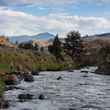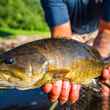One of America’s most iconic — but troubled — fishing destinations might be getting a helping hand from the voters of Florida on Nov. 4.
If the Land and Water Conservation Amendment is approved by Sunshine State voters, a full third of state fees collected from real estate transactions will go into a conservation fund that could be used to purchase or preserve important lands and waters that are vital to the health of the sport fishery in Florida.
According to Everglades Foundation CEO Eric Eikenberg, some of the money could be used to purchase thousands of acres of land directly below or adjacent to Lake Okeechoboee, allowing for water to be reintroduced into the Everglades rather than channeled into the Caloosahatchee and Indian rivers. If the amendment passes, it could create a $20 billion revenue stream over the next 20 years that can be used solely for conservation purposes in Florida.
The state’s population has doubled in size over the last 35 years, which has put a great deal of stress on Florida’s water resources. Additionally, agricultural use in Florida’s Kissimmee River basin — which includes Lake Okeechobee and the Everglades — has tainted the lake’s water, which makes the artificial discharges into the rivers troubling. Estuaries on both the east and west coasts of Florida are getting frequent doses of polluted fresh water at unnatural times over the course of the year. Fish and wildlife in the Indian River Lagoon have developed cancerous lesions and other maladies that have been blamed on tainted water discharges. The Caloosahatchee River estuary is tainted brown from its normal emerald green hue thanks to the frequent discharges.
Ideally, Eikenberg told a group of journalists gathered at the Theodore Roosevelt Conservation Partnership Saltwater Summit last week in Cape Coral, Fla., money from Amendment 1 would be used to not only purchase some of the land that is currently owned by sugar companies, farmers and ranchers, and is the source of much of the pollution, but it could be used to construct man-made artificial wetlands to treat the tainted water before letting it flow in the Everglades.
"Improving the water supply—improving the amount of water on the peninsula—it's for the betterment of all of us and it's a public health issue," Eikenberg told a local TV station.
While reducing toxic discharges into Florida’s rivers from Lake Okeechobee would be of great benefit to the state’s inshore fisheries and the Everglades, it won’t, by itself, solve all of the Everglades’ problems. The famed Tamiami Trail still cuts across the Everglades from one side to the other, effectively limiting the flow of water from the north to the south. Some progress has been made by elevating the road across portions of the trail — and more bridges are in the works — but until water can flow freely from the north to the south and eventually into Florida Bay, the Everglades will be still be starved of the one resource it needs most to keep its unique habitat and angling opportunities intact — water.

And, just like anywhere else, water is a resource worth fighting for in Florida. Amendment 1, while not the silver bullet that will solve Florida’s water problems, would represent a huge step forward in providing conservationists and state and federal water managers (the Army Corps of Engineers operates the locks that dump water into the Indian and Caloosahatchee rivers) with more tools to acquire land that could be used for things like storage and settling reservoirs, water treatment facilities and simple protection of intact resources, like springs and creeks that contribute to both salt and freshwater habitat that is so important to anglers.
Keeping in mind that fishing in Florida is worth $8.6 billion every year to the state’s economy (according to an American Sportfishing Association study), Amendment 1 would also seemingly make good economic sense. Additionally, the amendment wouldn’t add to the taxpayer burden — it would simply reroute existing revenue into conservation, taking the spending decision out of the hands of a state Legislature that is heavily influenced by the Big Sugar lobby. One potential pitfall — the amendment must be approved by 60 percent of the state’s voters.
But the amendment, according to Eikenberg, has cross-party support, and is largely supported by the state’s real estate industry. The toxic water discharges into rivers running into both of Florida’s coasts is apparently none too appealing to real estate brokers trying to sell waterfront homes while dead manatees and sea turtles wash ashore, riddled with tumors.
Anglers, too, stand to gain, for obvious reasons. Both the Indian and Caloosahatchee river estuaries are prime inshore fishing destinations known for everything from redfish and snook to tarpon, speckled trout, Spanish mackerel and sheepshead.
“These are the estuaries that serve as nurseries to our prized fish populations,” said Jim Bandy, chairman of the Snook and Gamefish Foundation. “We need to be creative with our solutions and find ways to overcome great political challenges in order to clean up these waters and keep fishing strong and viable in Florida. Amendment 1 makes good sense economically and environmentally—this should not be a political issue, but a common-sense issue that’s good for all Floridians, especially the millions of us who fish.”
To read more about angling in the Everglades, read our recent piece about Fly Fishing for Everglades Snook.
































Comments
ginkthefly replied on Permalink
It's Florida. The people will fuck it up.
Chad Shmukler replied on Permalink
They didn't.
It passed.
Pages